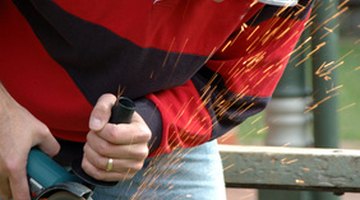OSHA Rules for Grinding Wheel Handles
A wheel grinder is a piece of machinery that’s used primarily for removing or smoothing metal. A wheel made of an abrasive material is spun at a speed that allows metal to be pressed and ground against it. This type of machinery is dangerous, as the speed at which the wheel spins would mutilate anything caught in its rotation. Also, the grinding metal gives off sharp debris and metallic dust that is hazardous to the operator's health.
Guards

OSHA requires several safety guards to be installed on any grinding wheel. First, the piece of machinery must be stable and electrically grounded. An enclosure must be erected around the wheel and operator to protect the surrounding area from flying debris. The enclosure also prevents against injury from flying shards should the wheel break while in operation. According to AM Trust North America, one of OSHA’s most commonly broken rules when it comes to abrasive wheels is the adjustable guard. An adjustable guard is required to be installed on the front of the machine to protect operators from the wheel while standing in front of it.
Rests
OSHA requires that a work rest always be used. A rest is a structure that can be used to support the piece you’re working on while you’re not working on it. AM Trust North America says this is the second most commonly broken rule. A rest must be rigid, structurally sound and adjustable to compensate for a wearing wheel. OSHA requires that the rest be no more than 1/8 inch away from the wheel; this close proximity ensures that the piece will not become lodged between the rest and the wheel. When you must adjust the rest, the wheel should be turned off and the rest should be properly clamped into place before work continues.
Personal Protective Equipment
OSHA requires all on-the-job machinery operators to wear personal protective equipment. Safety eyeglasses for protection from flying shards, gloves to prevent cuts from sharp edges, a dust mask to prevent inhalation of metal dust and hearing protection to prevent loss of hearing are all required by OSHA standards. Also operators are advised against wearing loose clothing that could potentially be snagged and dragged into the grinding wheel.
Spindle Regulations
The spindle is what the grinding wheel spins on. OSHA has set in place regulations regarding how the wheel and spindle are assembled and run. According to OSHA, the wheel must fit freely on the spindle at all times to prevent overheating of the spindle. It requires that spindles be undersized and wheel holes be oversized to ensure that spindles won’t expand under heat and pressure and cause the machine to break down.
References
Resources
Writer Bio
Michaelyn Erickson has been writing since 2005 and has been published regularly in a variety of northwest publications. She has written a science fiction novel and is now working on a children's book series. Michaelyn attends Evergreen State College where she is pursuing a degree in sustainable living.
Photo Credits
- A man grinding metal image by Coralie Palmeri from Fotolia.com
More Articles



